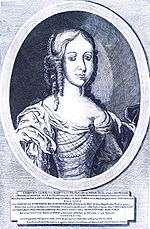Charles III Philip, Elector Palatine
Charles III Philip, Elector Palatine (4 November 1661, in Neuburg – 31 December 1742, in Mannheim) was a ruler from the house of Wittelsbach. He was Elector Palatine, Count of Palatinate-Neuburg, and Duke of Jülich and Berg from 1716 to 1742. Until 1728 Charles III Philip was also Count of Megen.
| Charles III Philip | |
|---|---|
| Elector Palatine | |
.jpg) Charles III Philip, Elector Palatine | |
| Elector Palatine | |
| Reign | 8 June 1716 – 31 December 1742 |
| Predecessor | John William |
| Successor | Charles Theodore |
| Born | 4 November 1661 Neuburg an der Donau |
| Died | 31 December 1742 (aged 81) Mannheim |
| Spouse | Ludwika Karolina Radziwiłł Teresa Lubomirska Violente Theresia of Thurn and Taxis |
| Issue | Leopoldine Eleonore of Neuburg Maria Anna of Neuburg Elizabeth Augusta Sophie, Countess Palatine of Neuburg Theophila Elisabeth Franziska Felicitas of Neuburg Anna Elisabeth Theophila of Neuburg |
| House | House of Wittelsbach |
| Father | Philip William, Elector Palatine |
| Mother | Elisabeth Amalie of Hesse-Darmstadt |
Biography
Born in Neuburg an der Donau, Charles Philip was the seventh of 17 children of Philip William, Elector Palatine and Elisabeth Amalie of Hesse-Darmstadt.
Though Charles Philip became a cleric in Cologne at the age of fourteen in 1677 in Salzburg, and again in 1679 in Mainz, he was not ordained but instead started a military career in 1684. He then joined the Habsburg war against the Turks 1691–1694 and was promoted imperial field marshal. In 1712 he was appointed Governor of Further Austria in Innsbruck.
Charles Philip succeeded his brother Johann Wilhelm, Elector Palatine on his death in 1716. He moved the Palatinate's capital from Heidelberg to the new city of Mannheim in 1720, but not before promoting his favorite court jester, Perkeo of Heidelberg, to be in charge of the castle's wine stocks. To strengthen the union of all lines of the Wittelsbach dynasty Charles Philip organized a wedding on 17 January 1742 when his granddaughter Elizabeth Auguste was married to Charles Theodore of Palatinate-Sulzbach and her sister Maria Anna to the Bavarian prince Clement. In the imperial election a few days later Charles III Philip voted for his Bavarian cousin Prince-Elector Charles Albert.
Upon his death in December 1742, the Palatinate-Neuburg line became extinct, and the Electorate of the Palatinate (including Neuburg, Jülich and Berg) was inherited by Charles Theodore of the Palatinate-Sulzbach line of the Wittelsbach family. Another granddaughter of Charles Philip, Countess Palatine Maria Franziska of Sulzbach, was later married to Count Palatine Frederick Michael of Zweibrücken. Their son Maximilian I Joseph of Palatinate-Zweibrücken became the heir of the Palatinate-Sulzbach line.
While in Mannheim, Charles III Philip, and later his successor Charles IV Theodore, put together what was commonly regarded as the finest orchestra in all of Europe. Under the leadership of musicians such as Johann Stamitz and Carlo Grua, the orchestra of the Kapelle was lauded by such musicians such as Leopold and Wolfgang Amadeus Mozart.
Marriages

Charles Philip married three times:
- In Berlin on 10 August 1688 he married firstly Princess Ludwika Karolina Radziwiłł, dowager margravine of Brandenburg and a wealthy heiress in Lithuania. They had four children although only a single daughter, Elisabeth Auguste, lived to adulthood:
- Leopoldine Eleonore Josephine (b. Brieg, 27 December 1689 – d. 8 March 1693).
- Maria Anna (b. 7 December 1690 – d. 1692).
- Elisabeth Auguste Sophie (b. Brieg, 17 March 1693 – d. Mannheim, 30 January 1728), married on 1717 to her kinsman, the Count Palatine Joseph Karl of Sulzbach.
- Stillbirth son (b. and d. Brieg, 22 March 1695). The mother, Ludwika, died a few days later due to complications giving birth to this child.
- In Kraków on 15 December 1701 he married secondly Princess Teresa Lubomirska, heiress of Ostroh. They had two daughters, neither of which though lived beyond the age of 3:
- Theophila Elisabeth Franziska Felicitas (b. 13 November 1703 – d. 31 January 1705).
- Anna Elisabeth Theophila (b. Innsbruck, 9 June 1709 – d. Innsbruck, 10 February 1712).
- In 1728 he married thirdly Countess Violente Theresia, (1683–1734), daughter of Count Philipp-Wilhelm of Thurn and Taxis, and his wife, Countess Marie-Adelheid von Aham zu Wildenau. This childless union was morganatic, as the Augsburg branch of the wealthy Thurn and Taxis family had only been elevated to baronial rank in 1657 and made counts of the Empire in 1701. But Violente received the honorary title of Princess from Holy Roman Emperor Charles VI in 1733.[1]
Ancestry
Notes
- Huberty, Michel; Giraud, Alain; Magdelaine, F. and B. (1985). L'Allemagne Dynastique. Tome IV (in French). Laballery. pp. 200, 235–237. ISBN 2-901138-04-7.
External links
![]()
Charles III Philip, Elector Palatine Born: 1661 Died: 1742 | ||
| Regnal titles | ||
|---|---|---|
| Preceded by John William |
Duke of Jülich and Berg Count Palatine of Neuburg Elector Palatine 1716–1742 |
Succeeded by Charles Theodore |